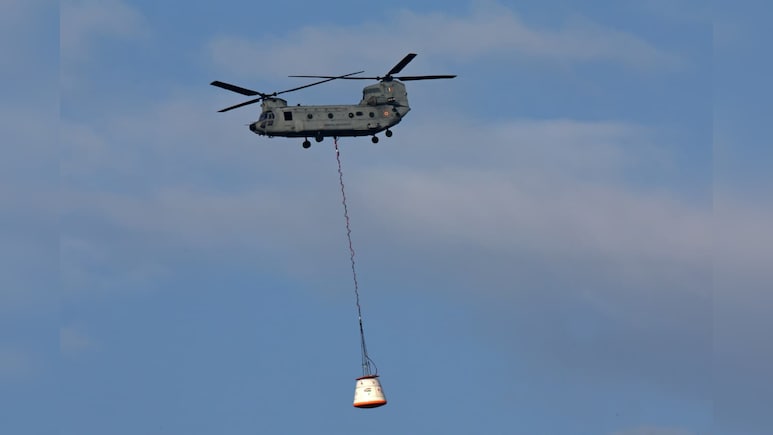
- Parachutes for Gaganyaan crew module tested by IAF Chinook helicopter over Bay of Bengal
- ISRO conducted successful Integrated Air Drop Test with 10 parachutes for deceleration system
- Test simulated free fall from 3 km altitude, parachutes slowed 4.5-tonne crew module safely
The lives of Indian astronauts will literally hang by thread when they return to Earth -indigenously made parachutes will help slow down the craft before its splashdown in the sea. A Chinook helicopter of the Indian Air Force was used recently to test the reliability of these nylon strings -- the massive parachutes creating a celestial rangoli in the sky over the Bay of Bengal.
In a statement, ISRO said today that it has "successfully accomplished the first Integrated Air Drop Test for end-to-end demonstration of parachute-based deceleration system for Gaganyaan missions".
This test is a joint effort of ISRO, Indian Air Force, Defence Research & Development Organisation or DRDO, Indian Navy and Indian Coast Guard.
In the test, an IAF Chinook helicopter hoisted a simulated crew module to altitude of about 3 km above the Bay of Bengal. It then dropped the nearly 4.5 ton module in a free fall over the sea.
ISRO Chairman Dr V Narayanan asserted that the first un-crewed mission of the Gaganyaan will happen in 2025 and this parachute test was a critical step towards it.
In the integrated air drop test, one after another, ten different parachutes of various diameters opened sequentially to gently bring the crew module safely into the landing zone, said an officer from Aerial Delivery Research and Development Establishment (ADRDE), Agra -- India's foremost parachute expertise laboratory.
The test gives a better understanding of how the parachutes would behave in off-nominal low-altitude conditions - say if the mission abort takes place at lift-off itself.
In a real-life scenario, when the astronauts return, the first parachutes will open around 7 to 11 km above the sea. At that point, the crew module would still be travelling at a whopping nearly 700 km per hour -- which is the cruising velocity of a passenger jet plane.
Through sequential aerodynamics, the 10 parachutes will reduce the velocity by nearly 25 times before splash down.
At the final touchdown, the velocity of the crew module will still be about 30 kilometers per hour and the astronauts will have to withstand this impact.
The life of the astronauts will literally hang by nylon thread as the crew module drift down on parachutes. The textile used in the swadeshi parachutes is all made in India and the largest chute has a massive diameter of 25 meters. While two of these may be enough, a third was added for safety.
Gaganyaan is India's single-most expensive scientific experiment costing upwards of Rs 10,000 crore and all national facilities are contributing for its success.
On this test, the expertise of the DRDO has been tested in tandem with the technology developed by India's space agency.
"Human space flight is a complex play of humans and machines, where safety of humans is paramount," said Dr Samir V Kamat, chairman, DRDO. Since "Gaganyaan is a prestigious national mission with an all-India approach, the DRDO is contributing with its best expertise in making special custom-made parachutes that will slow down the crew module as it goes in for touch-down," he said.
Earlier tests were conducted by the DRDO at Rail Track Rocket Sled facility of the Terminal Ballistics Research Laboratory, Chandigarh and the Babina Field Fire Range in Jhansi, Uttar Pradesh. The Crew Escape System test was conducted at Sriharikota.

